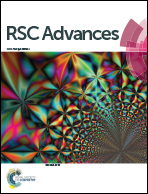Dimethyl homophthalates to naphthopyrans: the total synthesis of arnottin I and the formal synthesis of (−)-arnottin II†
Abstract
A simple and efficient 3-step synthetic protocol has been reported for dimethyl homophthalates to naphthopyrans. Starting from dimethyl 2,3-dimethoxyhomophthalate, a practical synthesis of arnottin I has been described via a base catalyzed mono-alkylation, the selective hydrolysis of an aliphatic ester moiety, two consecutive intramolecular cyclizations and an oxidative aromatization pathway with a very good overall yield. The involved intramolecular acylation followed by an associated enolative lactonization was the decisive step. The synthesis of dihydroarnottin I also completes the formal synthesis of (−)-arnottin II.


 Please wait while we load your content...
Please wait while we load your content...